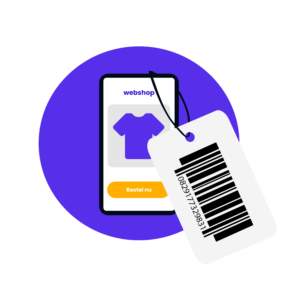
They are a requirement if you want to offer products as an e-commerce entrepreneur: “Global Trade Identification Numbers,” or GTIN codes. You may know them, as you need them for barcoding your products. There are multiple types of GTIN numbers, so don’t know exactly what it is or which one you need? We have an overview for you.
Why do I need GTIN numbers?
If you want to sell products, you will need GTIN numbers. This is because a GTIN number is a unique number by which your products can be identified internationally. The numbers can be linked to the product information of a particular product.Actually, you can think of GTIN as an identification system. There are several types of GTIN codes, the EAN number of which you probably already know. GTIN codes cannot be used only in Europe: certain types are also used in North America or Japan, and others just worldwide.
Gtin codes are managed and issued by GS1. Fun fact: GS1 is a nonprofit organization dedicated to making the supply chain more efficient and transparent. If you want to purchase codes, it is highly recommended that you do so through GS1. Indeed, that is the official publisher of these codes. Then you can be 100% sure that you will get a unique code. You may just find them cheaper with another party, but then you run the risk of not getting a unique number. The risk of that, is that your number will also be used for another type of product. Getting it right the first time will prevent a lot of hassle.
How is a GTIN number constructed?
A GTIN number consists of a number of digits. These may be eight, 12, 13 or 14. How many digits the number has depends on a number of factors. For example, it may depend on the item, location or shipping unit.
As an example, let’s take a GTIN-13 code: 87 10400 31114 0.
The first two digits, in this case 87, make up the country code (also called system code). 87 Is the country code for the Netherlands. The country code indicates where the code was issued. So it does not necessarily mean that the product was produced in the Netherlands!
The next five digits form the connection code, here 10400. The system code and the connection code together are called the company number. In the example, 8710400 refers to a company we are all familiar with: the Albert Heijn. It is good to know that a company can have multiple connection numbers.
The five digits that follow, 31114, specify the item.
Finally, the last digit in the sequence forms a control number. Here it is 0, but it can be any other number. The control number is used to look up the bar code if one of the bars of the code is corrupted: you could think of it as an auxiliary number.
If you find a GTIN-14 code, there is another digit added indicating the type of packaging.
Types of GTIN codes
- UPC: this stands for “Universal Product Code” and has 12 digits. As a result, the code is also known as GTIN-12. The UPC code is widely used in North America for bar codes.
- EAN: this abbreviation stands for “European Article Number.” The code has 13 digits (sometimes also 14), and is therefore also called GTIN-13. EAN numbers are commonly used for bar codes of European products.
- JAN: This stands for “Japanese Article Number.” A JAN code has 8 or 13 digits. This code is also sometimes referred to as GTIN-13. This version of the GTIN code is used for bar codes only in Japan.
- ISBN: this abbreviation stands for “International Standard Book Number.” You have an ISBN-10 (obsolete) or an ISBN-13 (updated). This code is used worldwide to identify books published from 1970 onwards.
To make it even clearer, also the overview the other way around:
- GTIN-8: most commonly used for EAN-8 bar codes.
- GTIN-12: most commonly used for UPC bar codes.
- GTIN-13: most commonly used for ISBN, JAN and EAN-13 bar codes.
- GTIN-14: used for wholesale products or multipacks.
GTIN number request
Want to request a GTIN number? This is best done at GS1. Indeed, that is the official publisher of such codes. You may just be able to get the codes cheaper from another party, but the danger then is that you won’t be able to use them in your trademark registration or link them to your name. If you request them from GS1, you can be sure your codes are unique.
Are you an Amazon seller? Then it’s extra important for you to purchase your codes through GS1. This is because then you must necessarily have codes from GS1, otherwise you cannot create listings with them on Amazon. If you do try it with a different code, chances are you’ll wrongly use another seller’s code, or you’ll be banned from creating listings by Amazon. Do you use unofficial codes anyway? Then for every product with such an unofficial bar code, you will have to request an official one from GS1. It saves a lot of work if you get it right the first time, that is!
